The IT outsourcing market is more dynamic than ever before, and is expected to reach US$512.50 billion in 2024, as predicted by Statista. According to the same report, this market is expected to show an annual growth rate (CAGR 2024-2028) of 10.99%, resulting in a market volume of US$777.70 billion by 2028.
We, at SPD Technology, are tenured players in this market, operating as a trusted outsourcing software development company for 18+ years, delivering Dedicated Development teams, IT Staff Augmentation, and Offshore Development Center (ODC) setup services.
Being guided by our experience, we will provide you with a holistic overview of offshore software development services, highlighting all you need to know to start a fruitful partnership with a reliable vendor.
Offshore vs Onshore vs Nearshore Software Development
First, let’s clear out the three most common terms that sometimes are mixed up, and talk about the distinct characteristics of each.
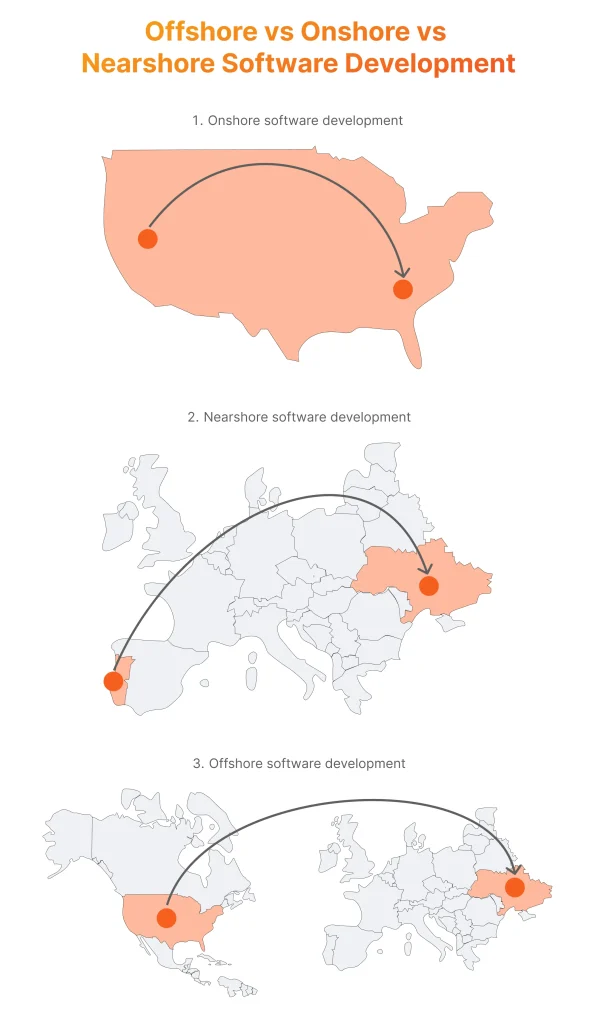
Offshore Software Development
This type involves outsourcing software development tasks to a third-party service provider located in a different country and in most cases in a different time zone.
Pros
- The main reason to opt for offshoring is cost-effectiveness, as companies choose a country with lower labor costs, achieving significant savings while receiving the same quality of development services.
- Additionally, hiring an offshore software development team allows for going beyond the local talent, so there is a possibility to tap into a vast pool of skilled developers from around the world, finding the most narrow expertise and skill sets.
Cons
- The main challenges here are related to distance, as time zone differences and language barriers can lead to communication difficulties, with some vendors.
- Cultural nuances of different countries may also affect understanding and collaboration. Finally, physical distance may result in less direct control over the development process, which may be critical in some cases.
Onshore Software Development
This one involves hiring a third-party service provider located within the same country or region as the client.
Pros
- You may expect better communication and collaboration, due to the proximity of the two parties and minimized language and time zone differences.
Cons
- Onshore development tends to be more expensive due to high labor costs.
- In addition to the same hourly rates of software developers for both the client and the vendor, the possible limited talent pool will be the same as well.
Nearshore Software Development
This type of software outsourcing is a middle-ground option where the outsourcing partner is located in a nearby country or within the same time zone.
Pros
- While not as significant as the offshore software development model, there can still be cost savings compared to onshore development.
- Closer time zones can facilitate overlapping work hours, and proximity allows for easier communication and collaboration.
Cons
Depending on the specific countries involved, there might still be some language and cultural challenges.
The choice between offshore, onshore, and nearshore development depends on various factors, including project requirements, budget constraints, the level of customer involvement, and the need for direct control. It’s crucial for businesses to carefully evaluate these factors to determine the most suitable outsourcing model for their specific needs. We, at SPD Technology, are strong believers that offshore software development benefits outweigh the other two approaches, and in the next section, we will provide a detailed explanation.
Advantages of Offshore Software Development
Let’s discuss why offshore software development services are more beneficial compared to other outsourcing options.
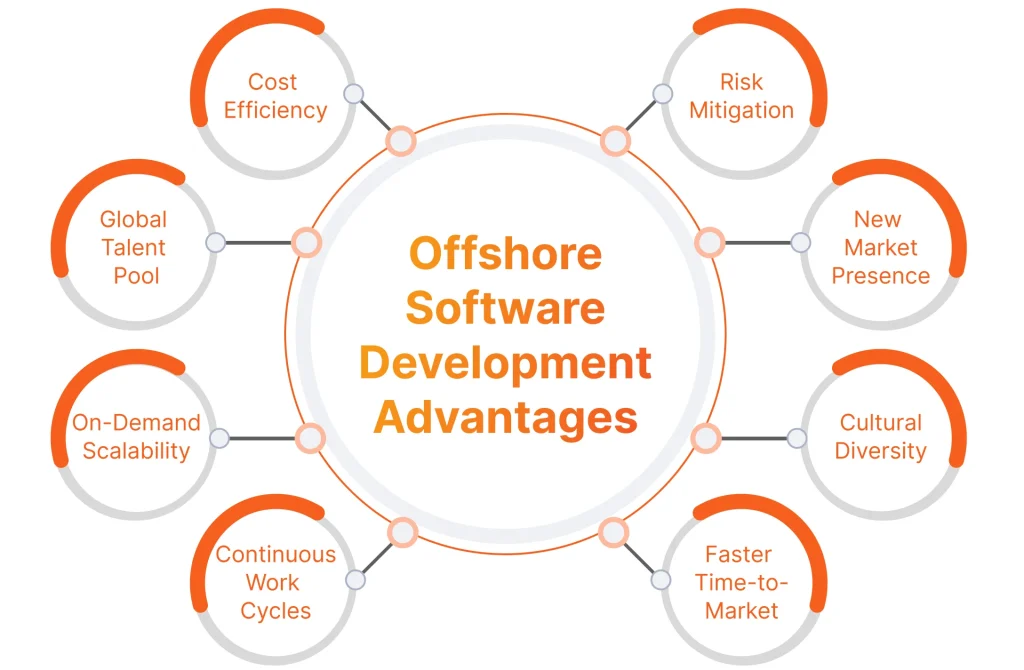
Cost Efficiency
Without a shadow of a doubt, the foremost reason to cooperate with an offshore software development company is to achieve significant budget savings. According to the Global Outsourcing Survey by Deloitte, 57% of companies chose software development offshoring to reduce operational costs. There are countries with an abundance of available professionals that could fulfill specific business and technical demands more cost-effectively than local talent.
With offshoring, you can achieve cost-efficiency thanks to:
- Global talent pool that can be accessed at a more affordable cost.
- The absence of significant investments in infrastructure, office space, and equipment.
- Access to the latest, more effective technologies.
- Favorable tax structures of certain outsourcing regions.
Olexandr Boyko
Delivery Director at SPD Technology
“Most businesses are interested in offshore software development as a cost-cutting opportunity. But in pursuit of higher revenues, make sure not to have the price as the principal factor in making a decision. Always remember that you will get what you pay for. You should look for an offshore software development partner that has a proven track record of delivering results, and not the lowest price tag.”
Access to the Global Talent Pool
Offshore software development allows companies to engage with developers, designers, and other IT professionals who possess a wide range of skills and expertise. You will certainly have more options to connect with seemingly any technological experts you require, from Artificial Intelligence (AI) and Machine Learning (ML) specialists to experts proficient in any modern programming language. Consequently, you will gain a competitive edge in your industry.
On-Demand Scalability
According to the above mentioned research by Deloitte, another major reason for hiring external talent is achieving additional scalability, with nearly 49% of surveyed business leaders using outsourcing to gain access to new capabilities. Offshore software development companies can provide experts for specific tasks and workloads, thus allowing you to scale your team up or down quickly.
Continuous Work Cycles
The cooperation with an offshore software development company can be set in a way that ensures work progresses continuously throughout the day and night, taking advantage of different time zones and achieving a 24/7 development workflow. Our talented project managers leverage this approach, and it delivers great results, especially in our project where development is conducted in Eastern Europe and America simultaneously.
Risk Mitigation
By engaging in offshore development, companies can mitigate risks associated with a single location. If there are natural disasters, political instability, or other unforeseen events in one region, the development work can continue in other locations unaffected by the same risks.
New Market Presence
With offshoring software development, companies can establish a presence in new markets without the need for a physical office. This expansion can help in reaching a broader customer base and tapping into emerging markets, unlocking new business opportunities.
Cultural Diversity
Finally, cultural diversity within remote teams can lead to increased innovation and creativity. Having different perspectives and approaches to problem-solving can result in more robust and comprehensive solutions, as well as unique perspectives on solving complex challenges.
Faster Time-to-Market
The speed of development is a crucial factor that determines your organization’s competitiveness. Opting for offshore development services will enable your business to deliver products more promptly by increasing your production capacities.
This advantage is especially important for startups and could be achieved by an efficient hiring process, parallel development by cross-functional distributed development teams, and focusing on developing MVP to quickly gather user feedback and make informed decisions on future iterations of the product.
Need help with hiring software developers for a startup? Read our detailed guide for more information!
Offshore Software Development Models
We already discussed engagement models in software development outsourcing that our company uses to deliver outstanding solutions to our clients. In this section, we would like to focus on the two most optimal options to hire offshore developers.
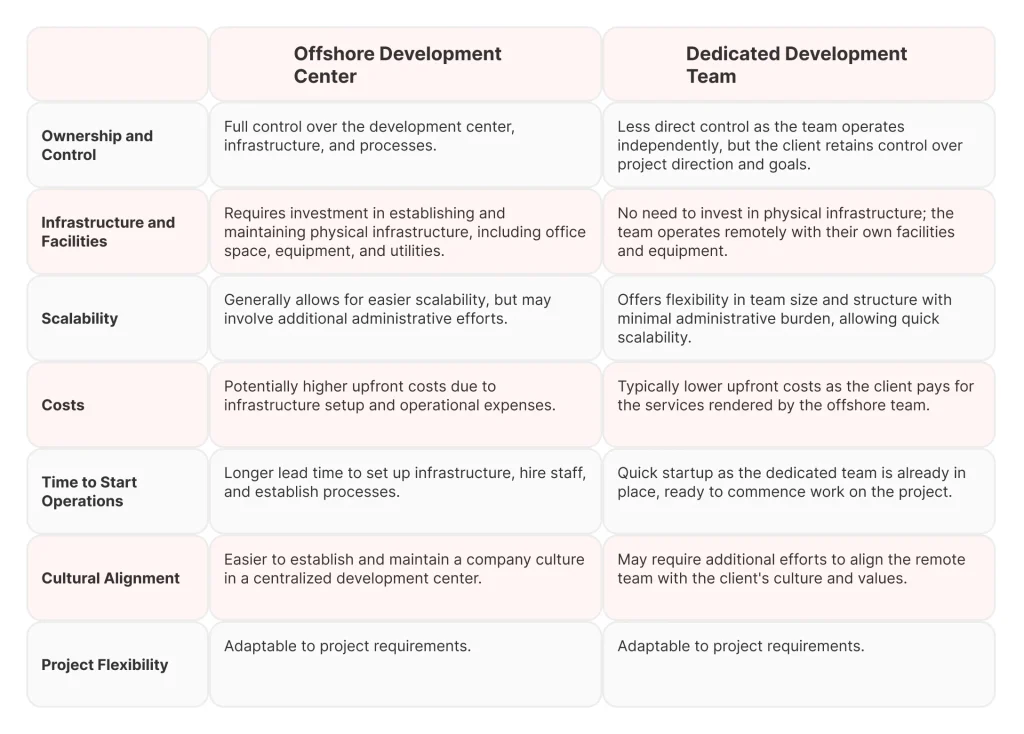
Setting Up an Offshore Software Development Center
In the Offshore Software Development Center model, a company sets up its development center in a foreign country by partnering with an outsourcing service provider. This center operates as an extension of the client’s organization and is dedicated to handling specific software development tasks and projects.
Key characteristics of this model include:
- The Offshore Development Center is a dedicated facility established exclusively for the client.
- The model typically involves a long-term partnership between the client and the service provider.
- The client retains a high level of control over the development processes, strategies, and resource allocation.
- The model allows for scalability, enabling the client to expand or reduce the team size based on project requirements.
Pros:
- The client has direct control over the development center, ensuring alignment with organizational goals and policies.
- Close collaboration and integration with the client’s existing teams lead to seamless workflows.
- The offshore center becomes an integral part of the client’s operations, retaining institutional knowledge.
Cons:
- Establishing an offshore center requires a significant initial investment in infrastructure and resources.
- The client bears the responsibility of managing the offshore center, including administrative tasks.
When the ODC model makes sense:
- You need to hire a large offshore development team.
- You plan for a big, possibly enterprise-level, project with ambitious scaling plans.
- You need to establish a market presence in a new region.
Do you want to find out how to set up an offshore development center? Read our article for more information.
Hiring a Remote Dedicated Development Team
In the Dedicated Team model, a client partners with an outsourcing service provider to set up a team of skilled professionals dedicated exclusively to the client’s projects. This team works the same way as ODC, you just hire a single or several teams, without opening an actual office. We already have an entire article on dedicated development team management, so if this offshore development services model suits your case, we invite you to read it.
Key characteristics of this model include:
- The dedicated offshore software development team typically comprises developers, designers, and other professionals chosen based specifically on the client’s project requirements.
- The client retains ownership and control over the projects, with the dedicated team working exclusively on those projects.
- The model provides flexibility to scale the team size up or down based on project needs.
- The dedicated team integrates seamlessly with the client’s existing processes and workflows.
Pros:
- The client can adjust the team size according to project requirements, so this model can be considered a scalable and flexible way to benefit from offshore software development services.
- The client pays only for the completed scope of work, making it a more cost-effective model, compared to ODC.
- The client can focus on core business activities while the dedicated offshore development team handles the coding tasks.
Cons:
- Communication challenges may be an issue when working across different time zones.
- The client fully relies on the outsourcing provider for team management, which may be a challenge if expectations are not met.
When a dedicated team model makes sense:
- You need to hire a single team of up to 8–10 experts.
- You aim for a quick project kick-off.
- You need overall flexibility, as well as human resource scalability.
Offshore Software Development: What Tasks Can Be Outsourced
According to Outsourcing Insight, 31.5% of IT services have been outsourced in 2024. Let’s specify in what areas offshore software development companies can help your organization.
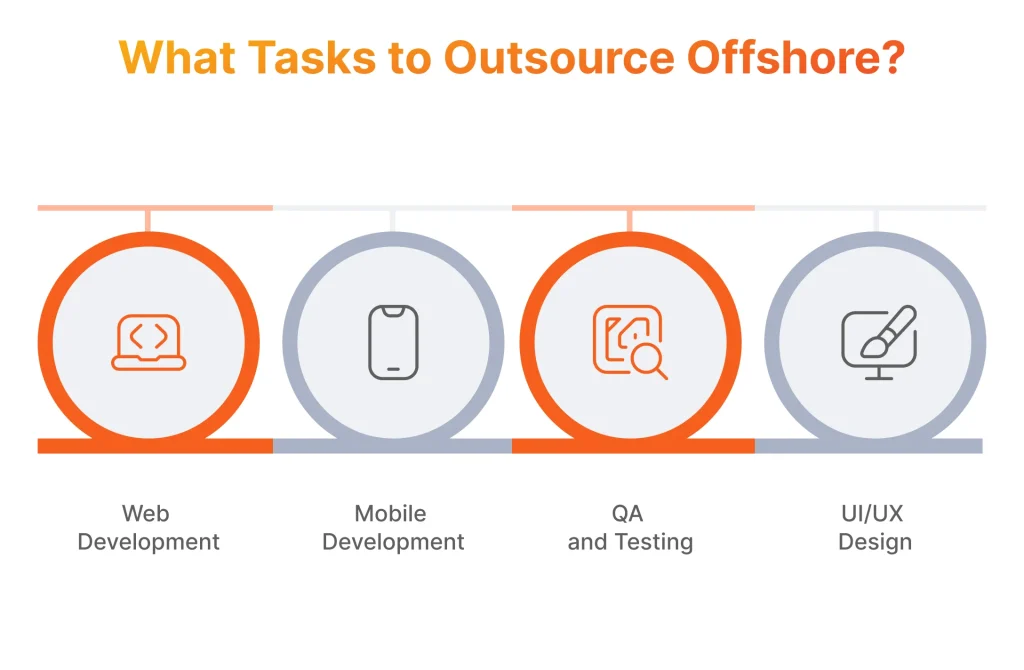
Web Development
Offshore software development companies can boost your online presence with a modern website or upgrade an existing one by offering professional web development services. In such a case, you will not be held back by the absence of local talent in your area or the necessity to train your existing team to keep up with the business demands.
For example, if you’re struggling to find web developers proficient in a legacy programming language, hiring an offshore software development team may be a good idea. Just like when we transformed a legacy notary service into a full-blown Legal Tech solution, helping our client to quickly find rare PHP and Angular to complete the project within a strict deadline.
Mobile App Development
If you are a startup that makes a mobile application, the time-to-market is the one crucial factor that will make or break your product. Here, an offshore software development team can ensure the necessary speed to deliver your app on time, if you find skilled app developers, of course.
Usually, offshore software development companies already have assembled teams that have a lot of experience working together and have a high level of communication among them. To ensure the best results, you’ll just have to pick an offshore software development company that will have the expertise, tech skills, and a proven track record of working with similar projects.
For one of our clients, we helped to create a computer vision-powered API for a Petcare mobile app, not only providing skilled mobile developers in the shortest amount of time but also developing complex AI-powered functionality.
Looking for help with mobile app development outsourcing? Find out our insights on this topic in a detailed guide.
UI/UX Design
Just like with any other type of expert, a proficient UI/UX designer can save your organization a lot of time with a solution that makes a complex interface simple to use in practice. An offshore software development company might have just the experts you need to create easy-to-use and intuitive interfaces for your website or app.
A great example of our UI/UX redesign is our legacy app improvement activities for an Investment Platform for a Western European client. Our experts implemented a visually striking and user-friendly interface design, aligning with contemporary design and usability standards, in addition to other offshore software development services SPD Technology delivered to the client.
QA and Testing
You may already have a bunch of outstanding programmers creating your product. However, to launch this product without bugs you need an experienced team of testers. An offshore software development company may offer you both QA Manual and QA Automation experts who will be able to test your software remotely in the most efficient way.
QA experts from SPD Technology help Roche, the world’s #1 pharmaceutical company and a leading provider of cancer treatments globally, to build medical device simulators remotely.
Our QAs on this project:
- Engaged in effectively testing software on real machines remotely.
- Developed the software Quality Assurance dashboard.
- Created automated tests that ensured 3x-4x time savings as compared with manual testing.
In addition to the services mentioned above, you can just as easily delegate to an offshore outsourcing software development company tasks for product maintenance, future improvement, or the development of security solutions. It is possible to outsource other services as well, for example, we conducted a software audit of one of the biggest libraries in the MENA region and created recommendations for software development and cost reduction of the entire client’s infrastructure.
Offshore Software Development Risks and Mitigation Strategies
There are certain challenges related to offshore development teams, as well as proven ways to deal with them. In this section, we will shed some light on the most common ones.
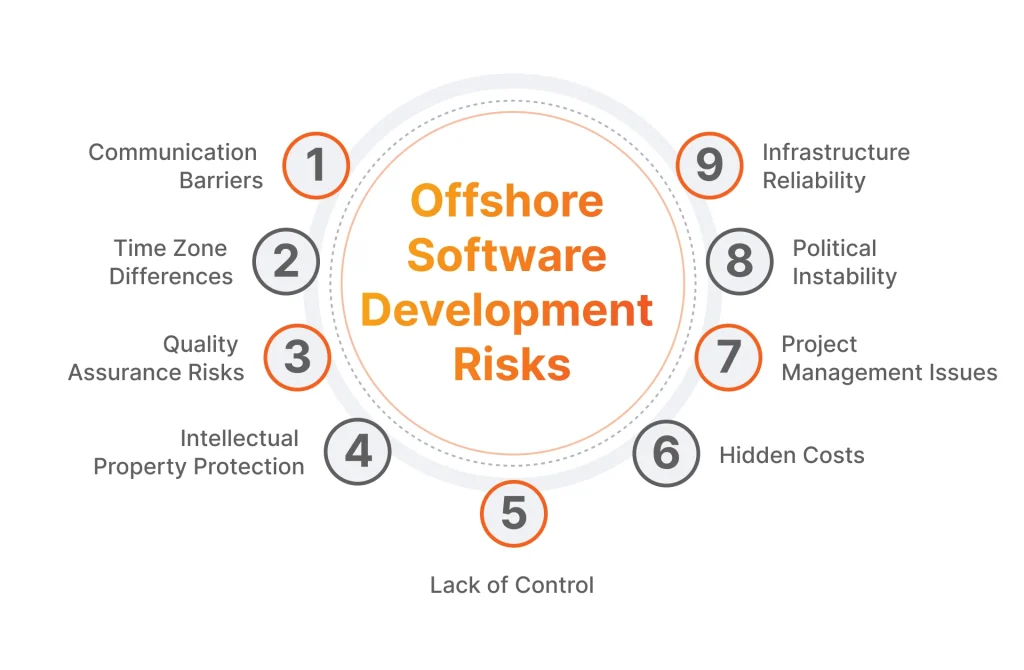
Communication Barriers
Unfortunately, offshore teams can sometimes be composed of people who are not fluent in English. Thus, language differences and cultural gaps are inevitably almost always an issue, at least to a certain extent. To deal with it, having local representatives might help.
At SPD Technology, for instance, we have local representatives in the US, the UK, and Israel to enable smoother communication. This approach helps us to improve our communication level even further, in addition to effective communication practices and an impressive level of English among our experts.
Mitigation Tips:
- Collaborate with vendors that have a relatively high level of English, at least among project managers.
- Establish clear communication protocols and use collaboration tools.
- Encourage and schedule regular video conferences to build a personal connection.
Time Zone Differences
Hurdles associated with the different time zones are unavoidable, but devoted vendors find ways to be available 24/7, ensuring the Continuous Work Cycles approach that was described in one of the sections above. With the right management, some time zone differences can prove to be favorable in establishing a non-stop process: the offshore developers will be working, when your in-house team is asleep, compromising on video calls in convenient time slots.
Olexandr Boyko
Delivery Director at SPD Technology
“While often considered unfavorable or risky, a time zone difference can prove to be a beneficial factor. When communication opportunities are limited, the teams on both ends will be driven to communicate better, save each other’s time, and make the most of the communication between the teams. This apparent limitation can become a hidden driver for boosting the effectiveness of the communication process.”
Mitigation Tips:
- Overlap working hours to facilitate productive real-time communication.
- Leverage asynchronous communication tools for documentation and updates.
Quality Assurance Risks
Offshore software developers may operate in diverse environments with different tools, methodologies, and coding standards. These variations can lead to inconsistencies in the way code is written, reviewed, and tested.
Additionally, offshore developers may follow different development processes, methodologies, or workflows than those used by the in-house team. This inconsistency can affect the integration and synchronization of code, testing, and deployment practices.
Mitigation Tips:
- Implement robust testing processes and conduct regular code reviews.
- Define and adhere to a comprehensive set of coding standards.
- Periodically conduct quality assurance audits to assess adherence to established standards and identify areas for improvement.
Intellectual Property (IP) Protection
Protecting IP rights and navigating legal complexities are crucial considerations while using custom offshore software development services due to the global nature of business collaborations. Unauthorized access to source code, algorithms, or proprietary information can lead to intellectual property theft and ambiguity in defining ownership rights over the developed software can lead to disputes.
Mitigation Tips:
- Implement robust confidentiality and Non-Disclosure Agreements (NDAs) with an offshore software development company.
- Clearly define ownership and IP rights in contractual agreements.
- Utilize legal expertise to navigate international IP laws.
Lack of Control
You may have to pay more attention than expected to manage your newly hired experts. However, with an IT partner that focuses on improving your business, understands its role clearly, and does not simply deliver the code, you may not encounter this problem at all.
Olexandr Boyko
Delivery Director at SPD Technology
“There are multiple ways to deal with this risk. Based on SPD Technology’s experience, we are offering multiple engagement models to provide on-site management and do our best to handle software development projects without any extensive involvement on the part of our clients. With a high management involvement on our end, the risks of any incorrectly developed or missing functionality and those of under-delivering are kept at an absolute minimum.”
Mitigation Tips:
- Share your business vision and goals with your outsourcing software development company, so they can understand your organization better.
- Implement efficient project management tools for maximum transparency.
- Regularly review progress and conduct audits for compliance.
In our dedicated article, our experts shared how to hire a dedicated development team hassle-free. You are welcome to read it!
It’s important for businesses to conduct a comprehensive cost-benefit analysis and carefully consider potential hidden costs. These costs can be related to inaccurate estimation of the scope of work, or something external like fluctuations in currency exchange rates.
Mitigation Tips:
- Conduct a comprehensive initial cost analysis.
- Review the Service-Level Agreement (SLA) carefully and make necessary adjustments when needed.
- Consider hiring a finance expert for consultations.
Project Management Challenges
Implementing effective project management for offshore software developers can be challenging due to various factors associated with geographical, cultural, and organizational differences. These challenges may impact communication, collaboration, and the overall success of the project.
Mitigation Tips:
- Introduce a unified project management framework that is agreed upon by all teams.
- Adopt Agile methodologies to enhance collaboration, flexibility, and responsiveness to changes throughout the development process.
- Establish clear communication channels, leverage collaboration tools, schedule regular video meetings, and provide comprehensive project documentation.
Political Instability
Political instability can lead to frequent changes in laws and regulations, affecting contractual agreements, data protection, and intellectual property rights, as well as increased government intervention, including nationalization, policy shifts, or changes in investment regulations.
Mitigation Tips:
- Keep your finger on the pulse of global and local political developments.
- Consider diversifying operations across multiple stable locations.
- Establish contingency plans for potential government interventions.
Infrastructure Reliability
Issues such as power outages, hardware failures, or network disruptions can impact the development process. Downtime due to infrastructure failures can result in delays in project timelines, loss of productivity, and potential data loss.
Olexandr Boyko
Delivery Director at SPD Technology
“In projects with significantly sensitive information, some additional security practices might be required. As has been the case with some of SPD Technology’s Fintech clients, each developer in an offshore team was provided a secured laptop to completely rule out any possible data leaks.”
Mitigation Tips:
- Work with an offshore software outsourcing company that has redundant systems and reliable infrastructure.
- Use redundant network connections, implement backup communication channels, and leverage collaboration tools that can work in low-bandwidth conditions.
- Choose a reputable provider with a track record of reliability.
- Regularly back up data and implement data recovery procedures if needed.
If you want to learn more about how to outsource app development and avoid major risks, feel free to read our article on this topic for more details.
How to Choose the Right Offshore Development Vendor
By following these steps, you can methodically evaluate and select the most suitable partner for your project. This structured approach enhances the likelihood of successful collaboration and the delivery of high-quality software solutions that meet your business objectives.

Step 1: Define Your Project Requirements
Clearly articulate your project objectives, scope, features, and technical requirements. Having a well-defined project roadmap will assist in finding a partner with the right expertise.
Step 2: Establish Budget and Timeline
Determine your budget constraints and project timelines. This will guide your selection process and help identify partners that align with your financial and schedule requirements.
Step 3: Research Potential Offshore Partners
Conduct thorough research to identify potential partners by utilizing online platforms, referrals, and industry networks.
Olexandr Boyko
Delivery Director at SPD Technology
“It will be a good idea to create a long list of potential vendors. While creating it, pay attention to the quality of their services, expertise, and security standards. Case studies, reviews, testimonials, and references will help you understand whether the experience of each offshore software company is legitimate.”
Step 4: Evaluate Technical Proficiency
Assess the technical skills and expertise of each potential partner. Conduct detailed reviews of their portfolios and examine their completed projects to ensure they have experience in technologies relevant to your project.
Step 5: Check Industry Reputation and Credibility
Investigate the reputation and credibility of each company within the industry. Look for client testimonials, reviews, and ratings to gauge their track record and reliability. If possible, contact previous clients of the vendor on the aspects of partnership that interest you the most.
Step 6: Assess Communication and Cultural Fit
Evaluate the offshore partner’s communication style and cultural fit, as effective communication and alignment with your organizational culture are crucial for successful collaboration.
Step 7: Review Security and Data Protection Measures
Examine the security protocols and data protection measures implemented by potential partners. Ensure they comply with industry standards and can handle sensitive information securely.
Step 8: Consider Past Performance and Case Studies
Review past performance by studying case studies and success stories. It will be a good idea to use your in-house tech experts to conduct the correct evaluation, and whether the potential vendors perform up to modern standards. This will provide insights into their ability to deliver quality solutions and meet client expectations.
Step 9: Choose Location Strategically for Project Resilience
Consider geopolitical factors, legal frameworks, and economic stability when choosing the offshore software development outsourcing location. This helps future-proof your project against potential risks associated with political instability or legal uncertainties.
Step 10: Perform Due Diligence on Team Stability
Assess the stability and expertise of the development team. Investigate their turnover rates, employee skill sets, and experience to ensure a reliable and capable workforce.
Step 11: Conduct Face-to-Face or Virtual Meetings
Arrange face-to-face or virtual meetings with shortlisted companies. This provides an opportunity to discuss project details, understand their approach, and assess their team’s capabilities.
Step 12: Negotiate and Finalize Contract Terms
Engage in negotiations to finalize contract terms, including pricing, payment schedules, project milestones, and intellectual property ownership. Ensure all aspects are clearly defined and agreed upon.
Top Destinations to Hire Offshore Developers in 2024
The right choice of location can make or break the potential partnership, as offshore software development rates will be tightly connected to the particular location.
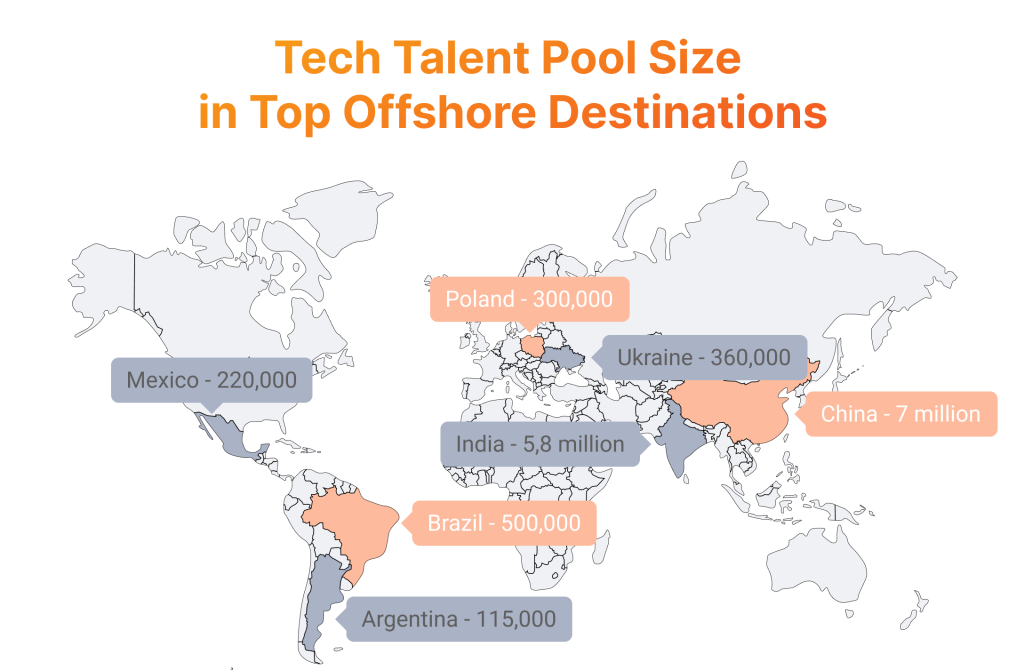
Here is a quick overview of the most popular outsourcing destinations, however when you conduct your research, make sure to pay attention to:
- Cost of labor
- Skill and expertise
- Education system
- Language proficiency
- Cultural compatibility
LATAM
With the minimal time difference, Latin America is usually the most preferable region for North American companies to approach and acquire experts. The LATAM IT services market is projected to grow at a CAGR of 8,7% between 2022 and 2027, while the most promising market segments are expected to be the Internet of Things (IoT) development and Big Data analytics.
This year, Latin America also stands out with the size of its tech talent pool. In 2023, there were approximately 500,000 software developers in Brazil. Mexico had around 220,000 software developers, while Argentina totaled approximately 115,000 specialists.
Asia
This region has one of the biggest talent pools for any offshore software product development, with its IT outsourcing market projected to reach US$113.90 billion by the end of 2024. India alone has over 5.8 million available experts! While this country offers an attractive offshore software development cost, with this massive amount of talent you may struggle to find experts with narrow domain expertise. Additionally, cultural differences and language barriers may become an issue.
China is the other country in this region worth mentioning, with nearly 7 million experts available, with its outsourcing market revenue forecasted to reach US$38.38 billion by 2030. While having this vast talent pool, as well as competitive costs, and technological advancements, businesses, working with China, should carefully navigate challenges related to language, culture, political situation, intellectual property, and cybersecurity.
Eastern Europe
While this region is not as massive as Asia, Eastern Europe has some of the most proficient experts, with the outsourcing market size projected to reach US$5.95 billion by the end of 2024.
Most experts in the region come from Ukraine and Poland. Ukraine alone is home to over 2,300 software development companies employing over 360,000 professionals, most of them ready to work as offshore software developers. Being one of the leading software development outsourcing destinations globally, Eastern Europe stands out with the highest quality of development talent, strong technical background and practical experience, English proficiency, and shared business values with Western Europe and the USA.
Getting Your Company Ready for Offshore Software Development
We already discussed where and how to find an outsourcing software development company that will be ready to help you, but is your organization ready for this type of cooperation? Let’s discuss what you can do for the smoothest workflow.
Define Offshoring Scope
The first thing you need to decide is what you need to outsource and to what extent. It is important to analyze your organization to know its strengths, weaknesses, and needs. Sometimes, you might not need an outsourcing company or offshore partner at all, and hiring just a few experts via a staff augmentation arrangement will be just enough.
As a business owner, you must have a clear understanding of whether adding particular experts to separate departments in your organization will be enough, or whether delegating a considerable part of your business responsibilities to an offshore development company is essential for the future growth of your organization.
So, the real question is, “How much responsibility are you willing to delegate to another offshore or outsourcing software development company?”
While creating a software product, you have to cover:
- Software development
- Testing
- Design
- Business analysis
- Marketing needs
So, you need to decide how far you are willing to go with trusting another company in some, or in all of these areas.
Olexandr Boyko
Delivery Director at SPD Technology
“From our experience, one of the most common and effective approaches is when companies outsource the entire software development process offshore, including product management and marketing. This approach allows you to control the product development process more efficiently, as compared with product ownership delegation. However, on the development side, you may then need Business Analysts (BAs) and Project Managers (PMs) to make sure that everything goes according to plan and your project vision.
We also had projects where the entire product was created by our teams, while the client took care of the marketing activities and overall direction in accordance with their high-level vision. This approach is also a viable option if you find a trusted and experienced partner.”
Appoint a Product Owner
It is necessary to have a Product Owner for any scenario of cooperation with an outsourcing company. Even with the best team of seasoned offshore developers who can quickly begin and deliver results, it will still be wise to control the direction of your product development. Some companies, especially startups, focus on development speed so much that they lose direction. You need someone to make sure that your top-notch product is being created to solve real-life problems, and that this is being done in accordance with your initial vision.
It is obvious that one of the biggest challenges with any team of outside experts is that they struggle to understand the real problems of your company and thereby offer viable solutions. It is also obvious that outsiders will not have the same understanding of your internal processes as the people in your company. The nuances of your business context are the most difficult to reflect properly in the documentation because this kind of knowledge is often unstructured. However, with the right partner and a properly set-up communication process, this challenge is completely solvable. In fact, when you outsource the entire product ownership, you have to find a way to share your business vision to develop a product the way you want it to be.
You could share the context and provide your offshore development team with a deeper understanding of your organization. Great product ownership and communication are a major part of delivering this understanding to the fullest extent. A Product Owner on your side can bridge the gap between the external and internal teams by being fully aware of both the business and development aspects.
The responsibilities of a Product Owner include, but are not limited to:
- Defining and prioritizing the product backlog
- Understanding stakeholders’ needs
- Setting product vision and strategy
- Release planning
- User story creation
- Acceptance and validation of user stories
- Measurement of product success
- Budget management.
Ensure Remote Cooperation Readiness
Your organization must be able to welcome an extended team of experts and provide them with all the necessary resources and communication tools without causing any disruptions to your processes.
Your organization must be digitalized to the maximum extent, allowing effective online communication and collaboration. If you still have any key processes that rely on in-person meetings, physical signatures, or any other processes that cannot be digitized, your company is not ready for a software outsourcing arrangement. You need to take care of your internal processes before adding any external teams.
In addition to supporting your teams with all the necessary tools, your Management must clear any communication roadblocks and make their virtual board meetings secure. Eliminating all bottlenecks that prevent your company from effective offshoring cooperation is a benefit in itself, even if you don’t cooperate with a software development partner as yet. Digital transformation will improve your processes, saving your employees’ working time and thereby saving you money.
Manage Access and Permissions
Your system must be able to provide different levels of permissions to different user groups.
While outsourcing or offshoring your software development, you will face situations when limited permissions will be required for users to solve certain problems. Every system is unique. Some systems may already be able to provide such permissions by using some other existing software solutions, while others may have a single administrator role that is designed to grant only the “all or nothing” kind of access.
So, it is recommended that you implement a multi-role user hierarchy with varying permissions to ensure productive collaboration with your external teams. In fact, flexible access and permissions functionality are a must-have for large enterprises, while for smaller organizations, this can be an option that is worth considering.
Identify Dependencies
In addition to taking into account the implementation of flexible access and varying permissions for your external teams, it is also important to determine the dependencies inside your organization that may potentially block the operations of an external team.
An example of dependency can be when two different tasks for an in-house and outsource team require the same resources while there aren’t enough resources to do the tasks at the same time, making one task dependent on the other.
When you identify all the dependencies, you will be able to rule out the possibility of your departments’ activities blocking your external team.
Prepare Security Measures
If you have never used any external help before, some parts of your infrastructure, security-wise, can suit only your in-house team. Therefore, your security model must be reconsidered and readjusted for outsourcing cooperation to keep your project safe.
The most common practices for remote teams are:
- To always use a VPN.
- To work only with software that is recommended and pre-installed by your security department.
Get Your Team Ready
Despite the practice of using offshore software development services is quite common, some concerns regarding job security still may arise among your in-house team members. So, when you have an in-house team but need to scale your project development by setting up a dedicated team or ODC offshore, you keep in mind that you also have to provide your internal team members with the context for hiring remote experts.
Addressing the interaction between in-house and remote teams is equally important. While your in-house team members may be protective of some technologies and approaches they are used to, your responsibility is to facilitate communication and offer the correct perspective to your in-house team members. Ensuring both in-house and offshore teams feel valued fosters a collaborative environment, enhancing results and minimizing potential conflicts.
Need more practical tips? We have 6 pieces of advice to help CTOs in outsourcing product development in our article.
Relevant Recommendations to Offshore Software Development in 2024
The Business Research Company, predicts that by 2028, the global application development market size is expected to see exponential growth, as it will grow to US$1132.52 billion in 2028. To truly benefit from this expansion, and become a major player on the market, consider the following best practices for collaborating with an outsourcing software development company.
Invest Time and Effort in Clear Project Documentation
Clear and comprehensive project documentation has always been crucial in software development. It serves as a primary means of communication between the in-house and offshore teams, providing a detailed roadmap for the project’s execution. Make sure to outline project requirements, functionalities, and acceptance criteria. This document should serve as a relevant reference for all development teams.
Plan for Frequent Knowledge-Sharing Sessions
Having regular knowledge-sharing sessions helps bridge the gap between in-house and offshore teams. They facilitate a collaborative environment, enhance communication, and ensure that both teams are on the same page regarding project details and expectations. In addition to regular video meetings, you can also implement interactive workshop sessions to transfer knowledge more effectively.
Establish a Risk Management Plan
There will always be inherent risks, ranging from communication challenges to external factors like geopolitical instability. Establishing a risk management plan is crucial to identify, assess, and mitigate potential risks. To successfully create it, you need to:
- Identify potential risks related to communication, project scope, technology, and external factors.
- Evaluate the impact and likelihood of each identified risk to prioritize mitigation efforts.
- Develop strategies to mitigate or respond to identified risks. This may involve contingency planning, setting up alternative communication channels, or diversifying resources.
Prepare an Exit Strategy
Despite careful planning, there may be instances where terminating the partnership becomes necessary. An exit strategy helps ensure a smooth transition and protects the interests of both parties involved, so to build one you need to:
- Clearly define terms related to contract termination in the legal agreements.
- Establish procedures for the retrieval and ownership of data, code repositories, and other project assets.
- Develop a transition plan outlining how responsibilities will be handed over.
- Ensure that knowledge transfer sessions will be conducted properly.
Establish Transparency in Communication
Finally, this is the most important recommendation there is. It is vital to talk openly about the challenges – technical, business, and product-related ones. Also, try to find the appropriate solutions during the early stages.
Conclusion
Offshore software development has become an integral part of the global IT landscape, offering organizations the opportunity to leverage diverse talent pools, cost efficiencies, and specialized expertise. It offers tremendous opportunities for innovation and efficiency, provided that organizations approach it with a well-defined strategy, a commitment to overcoming challenges, and a proactive mindset toward collaboration and continuous improvement.
SPD Technology has been a trusted partner for companies around the globe for 18+ years and in 90% of our projects, we serve as an offshore software development service provider that not only delivers software but also becomes part of the corporate culture of our clients. In one of our long-term projects, we have developed a solution for a Financial industry giant from scratch. We designed the system’s microservice architecture and provided overall consulting, ongoing development, maintenance, and support. With this remarkable partnership lasting for over a decade, we have managed to organize the work of 200+ experts based in 4 countries, interacting with them 24/7.
We are strong believers that offshore software development services are not just a cost-cutting measure or a way to connect with a larger talent pool, but a strategic partnership that can become one of the main drivers of your business growth. You are welcome to get in touch with us and discover how our technical expertise can accelerate your business expansion offshore!
FAQ
- What is Onshore and Offshore in Software Development?
Onshore software development refers to the practice of conducting software development activities within the same country or geographical location as the client’s headquarters or primary business operations, while offshore involves outsourcing software development tasks to a third-party service provider located in a different country or geographical region.
Offshore software development costs are typically lower compared to other options, and you will get broader access to a talent pool as well.
- How to Offshore Software Development?
Fully leveraging custom offshore software development services includes several key steps:
- Define objectives and requirements.
- Select the right development vendor as a partner.
- Establish clear communication channels.
- Clearly define roles, accesses, and responsibilities.
- Create detailed documentation, project specifications, coding standards, and design guidelines.
- How to Manage an Offshore Software Development Team?
Every case is unique and requires an individual approach to some extent, however, there are common managerial tips, and they include:
- Clearly defining project goals, expectations, and timelines.
- Ensuring that all team members are aware of their roles and responsibilities.
- Utilizing modern communication tools, conduct regular meetings, and ensure open and transparent communication.
- Implementing project management tools to track progress, manage tasks, and monitor milestones.
- How to Extend Your Offshore Software Development Team?
Prepare the requirements for the candidates you would like to extend the team with and get in touch with your offshore development vendor.
- How to Implement Agile in Offshore Software Development?
To effectively implement Agile practices, organizations should incorporate the following strategies:
- Clearly define Agile roles and responsibilities for development teams.
- Break down projects into small, manageable sprints and conduct regular sprint planning meetings to define tasks and priorities.
- Emphasize clear and transparent communication within the Agile framework.
- Implement continuous integration and deployment practices to ensure that changes are integrated into the project continuously and delivered promptly.
- Conduct regular retrospectives to reflect on the development process, identify areas for improvement, and implement changes in subsequent iterations.


